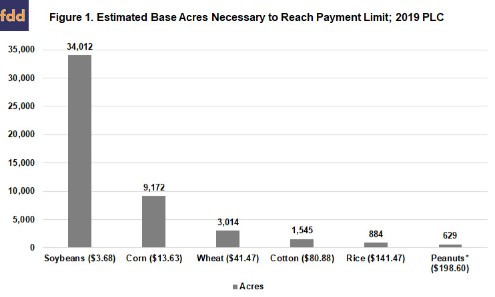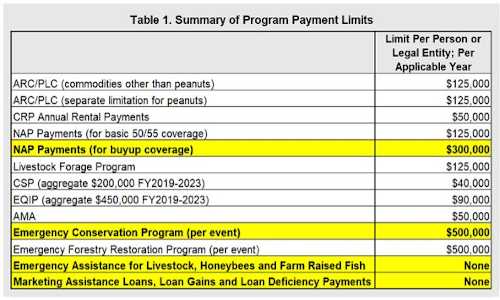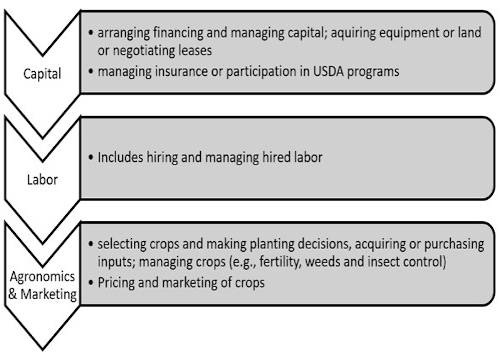By Jonathan Coppess and Gary Schnitkey et.al
Department of Agricultural and Consumer Economics
University of Illinois
By Carl Zulauf
Department of Agricultural, Environmental and Development Economics
Ohio State University
On Monday, August 24, 2020, USDA implemented changes to the payment limitation and eligibility rules for federal farm payments enacted by Congress in the 2018 farm bill (Abbott August 24, 2020; Brasher, August 24, 2020). The revisions were published in the Federal Register (GPO, Federal Register, August 24, 2020). This article reviews the latest changes in the regulation for payment limits and eligibility.
Background
From Oscar Johnston’s cotton plantation receiving large payments in the Great Depression to the Mississippi Christmas Tree schemes for multiplying payments, controversy regarding who should be able to receive federal farm payments and how much they should be able to receive has long embroiled farm programs (Coppess 2018; farmdoc daily, June 19, 2018; April 8, 2015). From controversy follow legislative and regulatory attempts to apply limits and restrict eligibility, including the “actively engaged in farming” eligibility requirement added by budget reconciliation in 1987. Efforts have recently focused on the ability for farms to add payments by qualifying managers, reforms that were political challenges in both the 2014 and 2018 farm bill debates (farmdoc daily, July 3, 2018; June 19, 2018). Monday’s regulation implements changes made by the 2018 farm bill.
Arguably, this is an issue of fairness; fairness among farmers of supported commodities and fairness to the American taxpayers who fund the federal payments. Challenges arise because limits and eligibility can have real economic implications but vary by program design. Figure 1 offers an example by estimating the total number of base acres that would be necessary to reach a $125,000 payment limit under the Price Loss Coverage (PLC) program based on the Congressional Budget Office forecast for 2019 program payments. At an average of $13.63 per base acre for corn, a farmer would need over 9,000 base acres to reach the limit, but at an average of $141.47 per base acre for rice, a farmer would need only 884 base acres to reach the limit. Note that farmers with peanut base have a separate limit for peanuts of $125,000 but that at an average of $198.60 per base acre, the separate limit would be reached with only 629 peanut base acres. By comparison, at an average $3.68 per bushel for soybeans, a farmer would need over 34,000 base acres to reach the limit. Note that, with the exception of peanut base, the limit is applicable to total payments across all commodities receiving payments.
In general, the higher payment rates for rice and peanuts result in the payment limits becoming effective on much smaller acreages. This, in turn, provides significant incentive for larger farms to undertake efforts to get around the limits. Methods for increasing the total number of applicable payment limits include adding family members to a farming operation or creating multi-level entities (e.g., a general partnership with limited liability company (LLC) general partners) and adding people to increase the number of applicable limits and payments. The statute provides exceptions for joint ventures and general partnerships such that the overall payment limit for such an entity equals the limit ($125,000) multiplied by the number of persons or legal entities with ownership interest. Thus, a general partnership with five general partners receives an overall limitation of $625,000 ($125,000 times 5 general partners).

Discussion
The new regulation makes a series of changes to the payment limitations and eligibility provisions for farm programs (7 CFR §1400.1 et seq.). The regulatory changes are implementing statutory changes from the 2018 farm bill, the Agriculture Improvement Act of 2018 (P.L. 115-334).
(1) Payment Limitation Changes
The 2018 farm bill made four changes to the general payment limitations: (1) removing application of payment limits from Marketing Assistance Loans (MAL), Marketing Loan Gains (MLG) and Loan Deficiency Payments (LDP); (2) removing application of the payment limit for the Emergency Assistance for Livestock, Honeybees and Farm Raised Fish Program (ELAP; (3) increasing the limit for noninsured crop disaster assistance program (NAP) payments for buyup coverage; and (4) increasing the Emergency Conservation Program (ECP) limit to $500,000 per disaster event. Table 1 summarizes the payment limits across programs with the changes highlighted; this discussion will focus on NAP and MAL changes.

The 2014 farm bill added the Marketing Assistance Loan (MAL) program, including for Marketing Loan Gains (MLG) and Loan Deficiency Payments (LDP), to the overall $125,000 limit for farm program assistance. Operationally, this would have applied any MLG or LDP benefits received to the overall $125,000 limitation, potentially reducing the amount available under the limit for ARC or PLC payments. The 2018 farm bill removed these benefits from the limitation so that a farmer may now receive an unlimited amount of MLG or LDP in addition to ARC or PLC payments. The MAL program assistance could be more relevant given that the 2018 farm bill increased loan rates and market prices have fallen significantly. For example, the corn loan rate was increased from $1.95 per bushel to $2.20 per bushel and the soybean loan rate was increased from $5.00 per bushel to $6.20 per bushel (farmdoc daily, December 12, 2018).
The 2018 farm bill also revised the payment limitations for NAP, which provides coverage for those crops and farms that do not have crop insurance policies available. NAP has traditionally provided catastrophic coverage, which covers a 50% loss at 55% of the value. The 2014 farm bill added buy-up coverage options to increase protection to 65% loss at 100% of the value. The 2018 farm bill split the payment limitation for NAP by coverage level, with $125,000 limit for catastrophic coverage and a $300,000 limit for the buyup coverage.
(2) Adding Family Members
The 2018 farm bill allowed farms to add additional members to the farming operation that qualify for payments, expanding the definition to include first cousins, nieces and nephews in addition to lineal ancestors and descendants and spouses. USDA’s regulation merely implements the change. Adding a family member is considered a bona fide and substantive change in the farming operation, which is required in order to add persons to the farming operation that increase the number of payments to the operation. In addition, family members are a special class for purposes of being considered actively engaged in farming and thus eligible for payments if they meet standard labor and/or management requirements, or if they elect to qualify based on having a commensurate share of profits, losses and risk in the operation.
In a traditional parent-adult child farming operation, each would be subject to a payment limit of $125,000 (plus an additional $125,000 if they have peanut base); under existing rules this limit can be doubled through a spouse (e.g., $250,000). Now the farm may add a first cousin, niece and nephew, each of whom may bring an additional $125,000 in potential payments (also doubling with spouses). For example, consider this traditional parent-child farm that adds an adult first cousin, adult niece and adult nephew, all married. Without adding anything further to the farm (e.g., acres or equipment), such a farm could increase the total payment limit from $500,000 (two adults plus spouses) to $1.25 million; five family members and their respective spouses with $125,000 limit each.
(3) Revising Active Personal Management for Actively Engaged in Farming
The active personal management provisions in the eligibility requirement for actively engaged in farming have been the subject of significant debate and disagreement. Dating to the 1987 changes, this involves adding non-farmers to the operation in order to increase the total payment limits (and payments received) for the operation. This was a sticking point in the 2014 farm bill and was sent to USDA to revise, which it did by limiting the number of non-family farm managers in a joint venture or general partnership that could be eligible for payments to a single farm manager with exceptions for up to three (farmdoc daily, April 8, 2015; GPO, Federal Register, December 16, 2015). The 2018 farm bill did not make any statutory changes to the actively engaged in farming provisions. The USDA regulation appears to mostly make technical changes to these requirements.
In general, active personal management requires personal participation in activities that are “critical to the profitability of the farming operation” and within one or more of managing capital, managing labor or managing the agronomics and marketing of crops. It defines capital as the funding for operating farm activities and it must come from sources that are separate and distinct from others in the farm, does not include the value of the person’s labor or management contribution and must be “a direct out-of-pocket input of a specified sum or an amount borrowed by the person or legal entity and does not include advance program payments.” Finally, these contributions must be significant, which for land, capital or equipment must be at least 50% of the person’s shares for the farm. It requires at least 1,000 hours in a calendar year of labor or 50% of the total hours for the person’s share of the total hours needed for operating the farm. Active personal management, to be significant, requires a contribution “on a regular, continuous and substantial basis” and at least 25% of total management hours required for the farm or at least 500 hours annually. A person can also contribute a combination of labor and management and the regulation contains a table for the hours necessary.

(4) Waiver of AGI Requirement
Finally, the rule implements a waiver provision included in the 2018 farm for the adjusted gross income (AGI) requirement of $900,000. For certain conservation contracts, the Secretary can waive the AGI upon determination that the contract is for “environmentally sensitive land of special significance” and that the waiver result in its protection. Such land includes habitat for threatened, endangered or at-risk species, native grasslands, wetlands that are unique, land with soils that are considered rare, unique or related, as well as land critical for groundwater recharge and lands with historical or cultural resources.
Concluding Thoughts
Based mostly on statutory changes from the 2018 farm bill, USDA has revised the regulations for payment eligibility requirements and limitations on federal payments. Payment limitations and eligibility remain one of the most intractable and frustrating issues in federal farm policy. What seems simple on its face—that only actual farmers should receive farm payments and that fairness requires no one farmer should get too much in federal assistance—has proven difficult to resolve in practice. The vast majority of farmers never hit the limits, are actually engaged in all aspects of the labor and management necessary for their farm operation and have little need or use for multiple entities or persons. There are, however, a select few for whom the limits matter due to a combination of program payment rates and the size of the farming operation. These persons and entities also tend to have considerable resources to deploy on avoiding limitations and even gaming the system. Seas of ink and much effort have gone into payment limits and eligibility but the end result remains the same: the operations for which they are intended find a way to avoid the limits and collect more in payments than permitted; advantages magnified by government largesse masked as assistance and underwritten by the taxpayer. All other farmers are stuck with the paperwork and guilt-by-association.
Source : illinois.edu